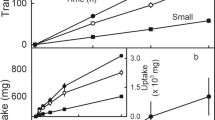Abstract
WHEN I was washing a population of date fruits collected from one and the same palm tree, variety “Hayyani”, I noticed that some fruits floated to the surface of the water while others sank to the bottom of the vessel. I then analysed samples of both floating and sunken fruits and found much smaller sugar content in the former than in the latter. It was therefore thought advisable to investigate the possibility of floating such fruits in water and also in aqueous solutions of sodium chloride as a criterion for segregation of such population into more or less homogeneous batches with regard to their sugar contents. This was done by putting the whole fruit population in a big vessel containing distilled water and then collecting all the fruits that floated as one batch ; the sunken fruits were afterwards put in aqueous solutions containing 2, 4, 6, 8 and 10 per cent pure sodium chloride, and in each case the floating fruits were collected, washed with distilled water and finally analysed (after excluding the seeds), together with the last batch which sank in the 10 per cent sodium chloride solution.
This is a preview of subscription content, access via your institution
Access options
Subscribe to this journal
Receive 51 print issues and online access
$199.00 per year
only $3.90 per issue
Buy this article
- Purchase on Springer Link
- Instant access to full article PDF
Prices may be subject to local taxes which are calculated during checkout
Similar content being viewed by others
Author information
Authors and Affiliations
Rights and permissions
About this article
Cite this article
NADA, I. Heterogeneity of Date Fruits. Nature 175, 469–470 (1955). https://doi.org/10.1038/175469b0
Issue Date:
DOI: https://doi.org/10.1038/175469b0
Comments
By submitting a comment you agree to abide by our Terms and Community Guidelines. If you find something abusive or that does not comply with our terms or guidelines please flag it as inappropriate.



